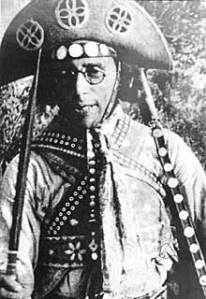As part of my dissertation I am looking into the history of the traditional Brazilian song “Mulher Rendeira” and I thought I would share my findings with the world. I first heard it on the soundtrack to Lima Barreto’s film O Cangaceiro and when I realised “Mujer Hilandera”, by Peruvian chicha band Juaneco y su Combo , was a Spanish translation of the same song it captured my imagination and got me thinking. Since then I have found 120 versions (and counting!), in 7 languages and from 16 countries. Quite a legacy for a song written by a 1920s cowboy in the Brazilian backlands about his grandmother!
“Olé, Mulher Rendeira, Olé mulhé rendá. Tu me ensina a fazer renda, eu te ensino a namorá”
I will present a different version of the song once every month or so, a feature if you like, and give a little background to the version and try to explain just how the song found itself being sung by the likes of The Shadows, German schlager star Heino and the The San Jose State Concert Choir. Read on to hear about the beginnings of the song and to hear version 1
I shall begin, as is custom, at the beginning. According to Frederico Maciel in his book Lampião: Seu Tempo e o Seu Reinado, “Mulher Rendeira” was originally penned in 1922 by the legendary cangaceiro Lampião in homage to his grandmother Tia Jacosa, herself a “mulher rendeira” or lace maker woman. The cangaceiros were social bandits” from the drought and poverty stricken north-east of Brazil in the late 19th/early 20th century who made a living by looting local landowners, taking hostages and raiding ranches. While they inspired either terror or a sort of mythic awe in the local population, the bandits, and in particular Lampião, became a thorn in the side of Brazilian national forces. While they tried to foster the image of a united, peaceful and “civilised” society the apparent lawlessness of the wild sertão backlands contradicted this notion of a modern, unified state. The sertão was a long way from Rio de Janeiro and São Paolo in the early 20th century.
Music played a key part in the cangaceiro way of life and the bands of cangaceiros would dance xaxado to songs such as “Mulher Rendeira”. Lampião in particular was renowned for his love of dancing and music. It is even recorded that the band sang the song as they attacked the city of Mossoró in 1927.
Vodpod videos no longer available.
Volta Seca – Mulher Rendeira (versão original), posted with vodpod
Version number 1 was recorded in 1957 by a Volta Seca, a former member of Lampião’s band, and is probably as close as we will get to hearing how the original may have sounded. This version was recorded and released on an album called Cantigas de Lampião released through the Todamerica label. For those who don’t speak Portuguese, the introductory remarks say:
“Here Volta Seca will present the authentic version of Mulher Rendeira. To the sound of this song the band of Virgulino Lampião attacked the great city of Mossoró, thankfully, he could not overcome the combined resistance from the inhabitants and the local police force.”

The word Rendeira doesn’t mean ‘weaver woman’, it refers to the Brazilian bobbinlace maker. ‘Renda’ is Portugese for ‘lace’, and is used both in Portugal and Brazil.
LikeLike
Thanks for the comment. I am aware ‘Rendeira’ refers to the lace making tradition in Brazil which has its roots in Portugal but wasn’t exactly sure of the correct term to use…I guess ‘lace maker woman’ is a better translation?
LikeLike
That’s as good a translation as any I’ve heard. What is more confusing is the second line. Does the word mulhé also refer to a woman? Lacemakers sometimes render the song as:
Hey there beautiful lacemaker
Oh what beautiful lace
Teach me to make lace
And I will teach you to make love
(or “teach you to flirt” which doesn’t go quite as far.)
It is absolutely amazing to see an expert lacemaker singing this song as she works. It is also one of the very few examples we have of folk dancing with actual lacemaking equipment. See http://www.youtube.com/user/lacenews
and look in the playlist “Brazil – Music”. Among the many versions of this song on YouTube there are about 16 sung by or about lacemakers, or choreographed with lacemaking equipment.
LikeLike
I think lace-making woman is better. But so much of this is untranslatable. Like “Aqui vem Lampiao, amando, gozando e querendo bem.” How would you put this in real English?
LikeLike
How about, “Here comes Lampiao, loving and enjoying life, wishing everyone well.”
LikeLike